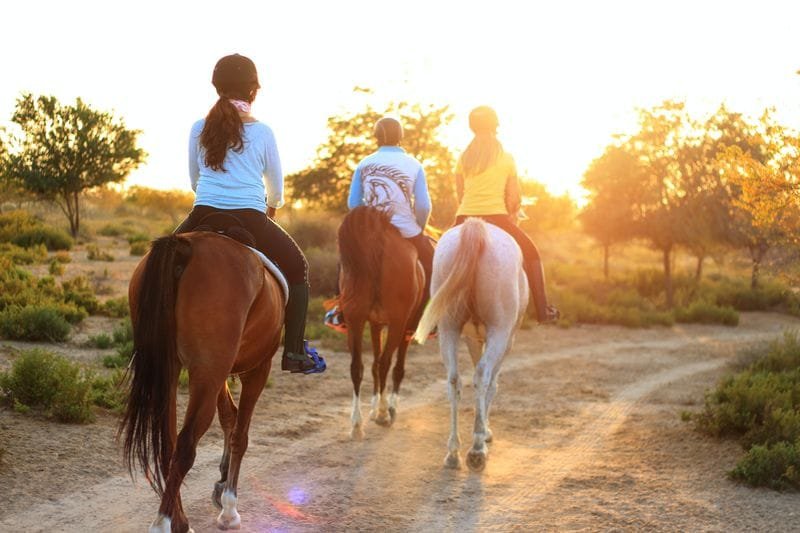Riding a horse is exciting, but it’s important to stay safe.
Always wear a helmet that fits well to protect your head. Use strong shoes with heels so your feet don’t slip. Check that all the gear on the horse is secure before you start riding. Understand how your horse behaves so you can predict what it might do. Pay attention to where you’re riding and use clear signals to control your horse. These tips help make sure riding is fun and safe for you and your horse.
1. Wear the Right Gear
Always wear a helmet that fits properly and meets safety standards. Helmets protect your head in case you fall off or get kicked. Wear boots with a small heel to keep your feet secure in the stirrups.
2. Check Your Tack
Before you start riding, check all the equipment on your horse—like the saddle and bridle—to make sure everything is in good shape and fits well. Tighten any loose straps and fix any problems before you get on.
3. Get to Know Your Horse
Every horse is different, so spend time with yours to understand its personality and habits. Knowing how your horse behaves can help you avoid surprises and handle situations better while riding.
4. Mount and Dismount Safely
Always mount and dismount from the left side (the near side) of the horse. Make sure your horse is calm and standing still before you get on or off. If your horse is tall, use a mounting block to make it easier.
5. Warm Up Before Riding
Start your ride with some gentle exercises like walking and trotting to warm up your horse’s muscles. This helps prevent injuries and gets your horse ready for more intense activities.
6. Ride with Confidence
Use gentle but clear signals to communicate with your horse. Use your legs, seat, and reins to guide your horse where you want to go. Avoid sudden movements that could startle your horse.
7. Be Aware of Your Surroundings
Always pay attention to what’s around you while riding. Watch out for things like rough ground, low branches, and other animals. Give other riders plenty of space to avoid accidents.

8. Follow Riding Rules
Obey any rules or guidelines for riding in your area. This includes things like staying on designated trails, following speed limits, and yielding to others on the trail.
9. Stay Safe in the Sun
If you’re riding in sunny weather, wear sunscreen and protective clothing to protect yourself from sunburn. Drink plenty of water to stay hydrated, especially on hot days.
10. Know What to Do in an Emergency
Carry a cell phone with you in case you need to call for help. Learn basic first aid for both you and your horse, like how to treat minor cuts or scrapes.
11. Take Riding Lessons
Consider taking lessons from a qualified instructor, especially if you’re new to riding. They can teach you important skills and safety tips that will make you a better rider.
12. Listen to Your Horse
Pay attention to how your horse is feeling during and after your ride. If your horse seems uncomfortable or unwell, stop riding and get help from a vet if needed.
13. Know Your Limits
Stick to riding techniques and speeds that match your experience level. Pushing yourself or your horse too hard can lead to accidents.
14. Maintain a Good Riding Position
Keep your heels down, sit straight, and balance evenly in the saddle. This helps you stay secure and communicate well with your horse.
15. Watch the Weather
Avoid riding in extreme weather conditions like very hot or cold temperatures, heavy rain, or strong winds. Dress appropriately for the weather when you do ride.
16. Listen to Experienced Riders
If you’re new or unsure about something, listen to riders who have more experience. They can offer helpful advice on handling horses and riding safely.
17. Respect Your Horse
Understand your horse’s limits and give them breaks during rides. Treat them gently and with respect—they’re living creatures with their own needs.
18. Follow Trail Etiquette
When riding on trails, yield to pedestrians and bikers. Keep your horse calm and avoid startling others on the trail.
19. Be Ready for Surprises
Stay calm if unexpected things happen, like your horse spooking or encountering wildlife. Think quickly and prioritize safety in any situation.
20. Check Your Equipment
Regularly inspect and maintain your gear—saddle, bridle, and stirrups. Replace worn-out or damaged equipment promptly to prevent accidents.
By following these simple tips, you can enjoy horseback riding safely and responsibly. Always prioritize your safety and the well-being of your horse. With practice and care, horseback riding can be a rewarding experience for everyone involved.




